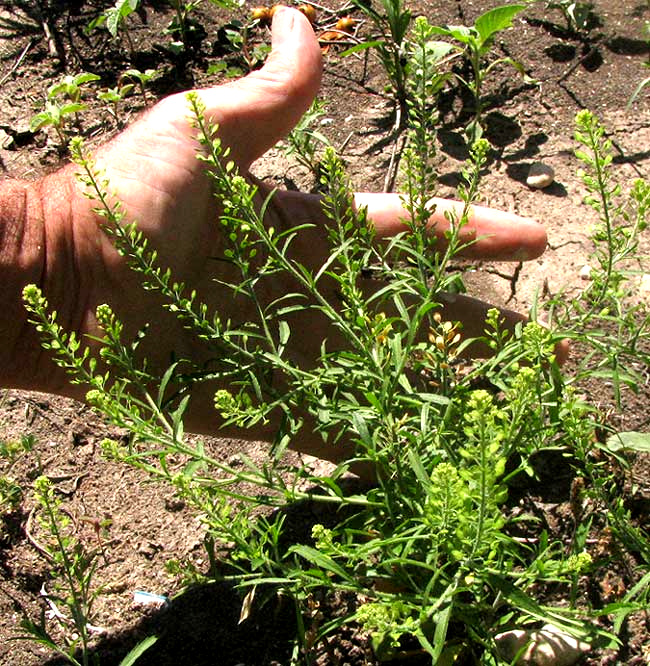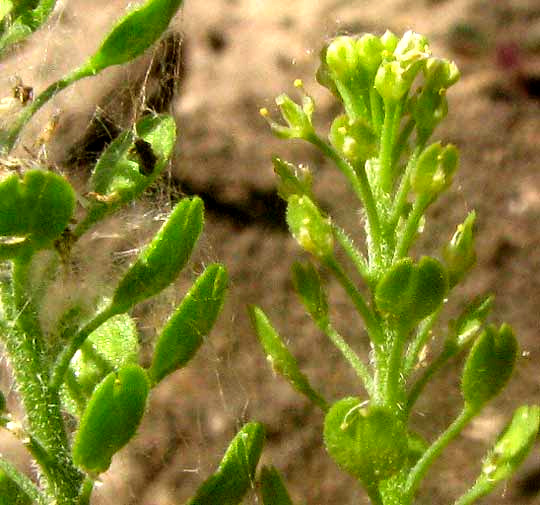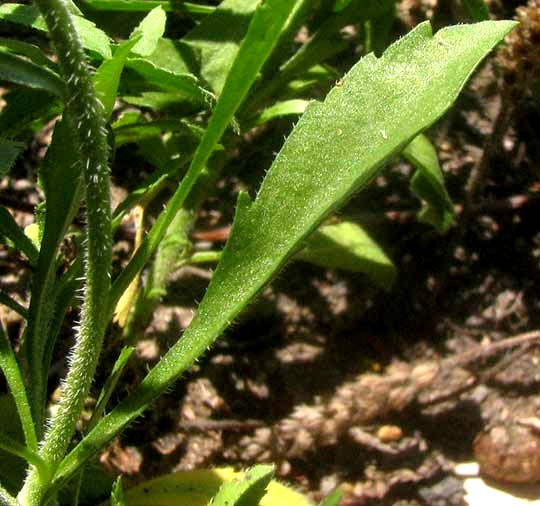Excerpts from Jim Conrad's
Naturalist Newsletter

from the June 15, 2014 Newsletter issued from the Frio Canyon Nature Education Center in the valley of the Dry Frio River in northern Uvalde County, southwestern Texas, on the southern border of the Edwards Plateau; elevation ~1750m (~5750 ft); N29.62°, W99.86°; USA
SOUTHERN PEPPERWORT
One of the most commonly encountered and easy to recognize spring wildflowers/weeds is the
pepperwort with its cylindrical, raceme-type flowering heads held above meager herbage like little pagodas. Above, you can see the effect with a pepperwort in my abandoned, leafcutter-ant-infested garden in the valley.
From the beginning, these pepperworts struck me as somehow different from the ones I'm used to in gardens and along roads and city sidewalks not only in the US but throughout most of Mexico. The Flora of North America reports that of the 220 or so known pepperwort species -- members of the genus Lepidium -- 42 are found in North America, so there's no reason why my garden pepperwort has to be the "usual species." You might enjoy comparing the above picture with one of the "usual species," Lepidium virginicum, a tough, vigorously adaptive species very common in North America coast-to-coast and south through Mexico and Central America, and invasive in much of the rest of the world, at http://www.backyardnature.net/yucatan/lepidium.htm.
For one thing, notice how our garden pepperwort's' flowers at the top of the racemes are so tiny and densely crammed together. A close-up of the flowers, as well as maturing flat, roundish fruits that on their pedicels look like green spoons with very slender handles and notches at the spoons' tips, is shown below:

One field mark distinguishing our garden pepperwort from many other pepperwort species is that it's an annual herb, not a biennial or perennial. Another is that our present pepperwort's flowers bear only two stamens, while flowers of some other species bear four. In the above picture, near the top, left of the flowering raceme you can see the very small, much reduced and simple flower -- this one even without petals -- with its two yellow-tipped stamens.
Usually but not always a plant' hairiness is regarded as a poor field mark, since often that feature varies from plant to plant of the same species, and hairs may fall off as plants mature. However, among the pepperworts, hairiness is something important to notice. Below you can see one of our garden pepperwort's shallowly and broadly toothed leaves with its slender petiole, as well as the stem's manifest hairiness:

A closer look, showing that the hairs are stiff, not soft, and that on the stem they tend to bend slightly downward, is shown below:
 .
.
This distinct kind of hairiness helps us separate our garden pepperwort from the very common species, which is less hairy, and when it bears hairs its hairs are softer and not so stiff.
Our garden pepperwort turns out to be what's often called the Southern Pepperwort, or Southern Peppergrass, LEPIDIUM AUSTRINUM. Unlike the very widely distributed "usual species," Southern Pepperwort is endemic only to Texas, Oklahoma, and arid northeastern Mexico, plus very spottily here and there in some other US states.
In general, pepperworts -- probably more often called peppergrasses though they're a long way from being grasses -- are members of the Mustard Family, the Brassicaceae. That sounds right because one of the first living-off-the-land tricks novice wildflower students learn is how pleasantly peppery the fruits taste when sprinkled onto a salad or nibbled from the hand. They can be easily harvest by pulling a raceme between two fingers. Below, you can see some immature, silicle-type fruits plus some mature seeds with their split pod coverings:
